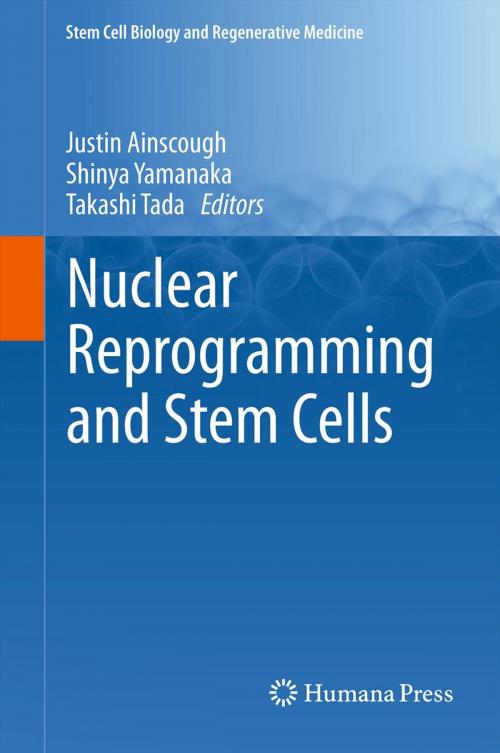Nuclear Reprogramming and Stem Cells
Nonfiction, Science & Nature, Science, Biological Sciences, Cytology, Other Sciences, Molecular Biology| Author: | ISBN: | 9781617792250 | |
| Publisher: | Humana Press | Publication: | September 2, 2011 |
| Imprint: | Humana | Language: | English |
| Author: | |
| ISBN: | 9781617792250 |
| Publisher: | Humana Press |
| Publication: | September 2, 2011 |
| Imprint: | Humana |
| Language: | English |
Research into the field of stem cell biology has developed exponentially over recent years, and is beginning to offer significant promise for unravelling the molecular basis of a multitude of disease states. Importantly, in addition to offering the opportunity to delve deeply into the mechanisms that drive disease aetiology the research is realistically opening the doors for development of targeted and personalized therapeutic applications that many considered, until recently, to be nothing more that a far fetched dream. This volume provides a timely glimpse into the methods that have been developed to instigate, and the mechanisms that have been identified to drive, the process of nuclear reprogramming, chronicling how the field has developed over the last 50-60 years.
Since the early 1950s a small number of notable experiments have provided significant impetus to the field, primarily the demonstration of reprogramming ability, first by the complex cytoplasmic milieu that constitutes the amphibian egg, then that of the mammalian egg, and finally that of the mammalian embryonic stem cell. Most recently, the demonstration that a limited pool of defined molecules is capable of reprogramming a multitude of cell types has provided massive impetus and facilitated transition towards realistic therapeutic application. We have therefore reproduced some of the key articles that elegantly document these dramatic stages of development of the field in an inclusive appendix to the book, for the benefit of readers keen to investigate the history of how the field of stem cell biology has evolved.
Owing to the ever broadening nature of this field, and the incredible rate at which it is evolving, the main content of this volume focuses on areas that have shown significant movement in recent years, are most likely to translate into personalized therapeutic application, and thus provide greatest potential for significant impact on human health in the not too distant future. We recognize that research into many other disease states and cell types are all equally worthy of discussion. We would therefore like to acknowledge those researchers involved whose work we have not been able to include in this volume. Nuclear Reprogramming and Stem Cells will serve as a valuable resource for all researchers in the field of stem cell biology, including those just setting out on their career path as well as those already established in the field.
Research into the field of stem cell biology has developed exponentially over recent years, and is beginning to offer significant promise for unravelling the molecular basis of a multitude of disease states. Importantly, in addition to offering the opportunity to delve deeply into the mechanisms that drive disease aetiology the research is realistically opening the doors for development of targeted and personalized therapeutic applications that many considered, until recently, to be nothing more that a far fetched dream. This volume provides a timely glimpse into the methods that have been developed to instigate, and the mechanisms that have been identified to drive, the process of nuclear reprogramming, chronicling how the field has developed over the last 50-60 years.
Since the early 1950s a small number of notable experiments have provided significant impetus to the field, primarily the demonstration of reprogramming ability, first by the complex cytoplasmic milieu that constitutes the amphibian egg, then that of the mammalian egg, and finally that of the mammalian embryonic stem cell. Most recently, the demonstration that a limited pool of defined molecules is capable of reprogramming a multitude of cell types has provided massive impetus and facilitated transition towards realistic therapeutic application. We have therefore reproduced some of the key articles that elegantly document these dramatic stages of development of the field in an inclusive appendix to the book, for the benefit of readers keen to investigate the history of how the field of stem cell biology has evolved.
Owing to the ever broadening nature of this field, and the incredible rate at which it is evolving, the main content of this volume focuses on areas that have shown significant movement in recent years, are most likely to translate into personalized therapeutic application, and thus provide greatest potential for significant impact on human health in the not too distant future. We recognize that research into many other disease states and cell types are all equally worthy of discussion. We would therefore like to acknowledge those researchers involved whose work we have not been able to include in this volume. Nuclear Reprogramming and Stem Cells will serve as a valuable resource for all researchers in the field of stem cell biology, including those just setting out on their career path as well as those already established in the field.















